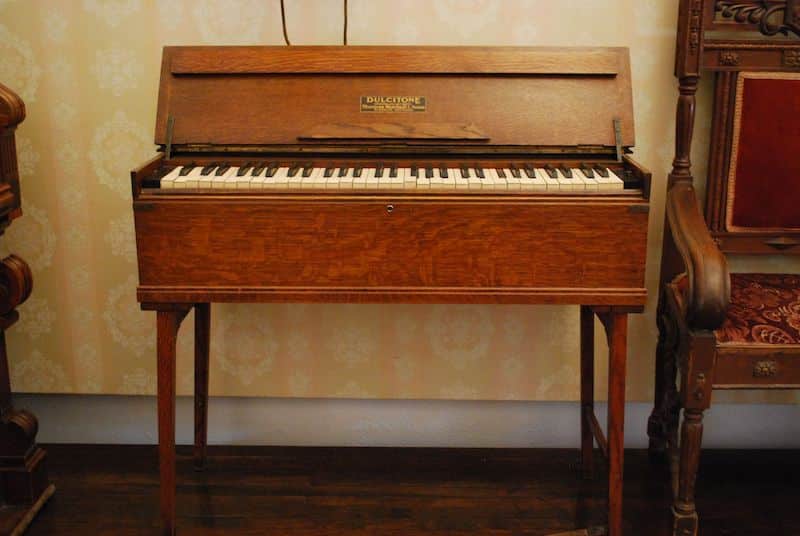Keyboards are incredible—the beauty and variety of sound that can come from them are simply astonishing.
Depending on who is playing and what song is being performed, the keyboard can be reminiscent of any type of emotion or memory. The one thing a keyboard can’t do, however, is sound like another instrument.
Some keyboards sound like vastly different instruments!
There are hundreds of keyboard instruments in the world, both historically and currently.
However, not that many of them are commonly used.
Even the fourteen on this list aren’t all as common as you would think—some of these you might not have heard of!
1. Piano

While the Piano is the most famous of the keyboard instruments, it’s not the first. The piano is a more modern reinvention of the harpsichord, which is still around and will be featured later on in this list.
However, the piano is by far the most played keyboard instrument. The modern piano has 88 keys and is played sitting down.
Originally, it was created to solve the musical problem of dynamics—musicians couldn’t control how loud or quiet their music was.
The piano was initially called the pianoforte, the common musical term for “soft” and “loud” (since it could do both). Now, it’s just called a piano.
2. Accordion
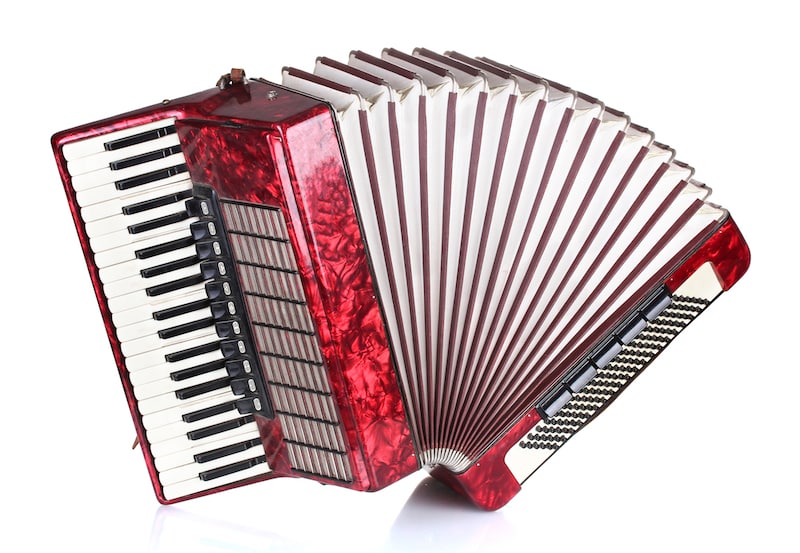
Although it’s not usually thought of as a keyboard instrument, the Accordion does deserve a spot on this list!
It is a classic portable instrument created in Germany. The accordion works like a tiny organ, using air, stops, and a keyboard to control the sound.
However, unlike an organ, it doesn’t use pipes. Instead, the instrument itself acts like a bellows.
Accordions are often used in polka and traditional European dance music. It’s technically a member of the wind instrument family (but the piano is technically a percussion instrument). Accordions are usually handcrafted and can be extremely expensive.
3. Harmonium
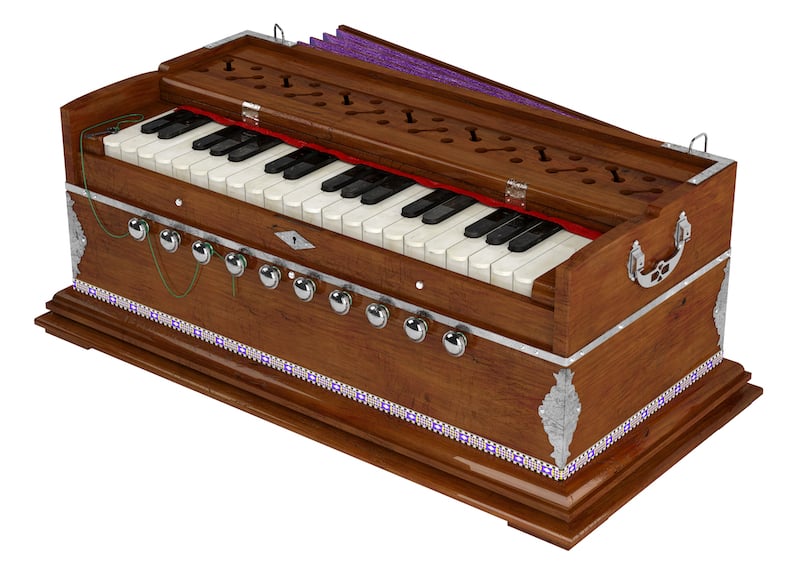
A Harmonium is a lesser-known cousin of the accordion. It works much the same way—blowing air through the instrument while controlling the sound with a keyboard.
However, the harmonium has two main differences: the method of air pumping and the size of the instrument.
A harmonium is like a small upright piano but with two large pedals. The air is blown upwards through the instrument’s reeds to create sound, which is then controlled by the keys.
It’s simpler than the accordion because there are no “stops” to control. However, a harmonium is much quieter and bulkier.
4. Harpsichord
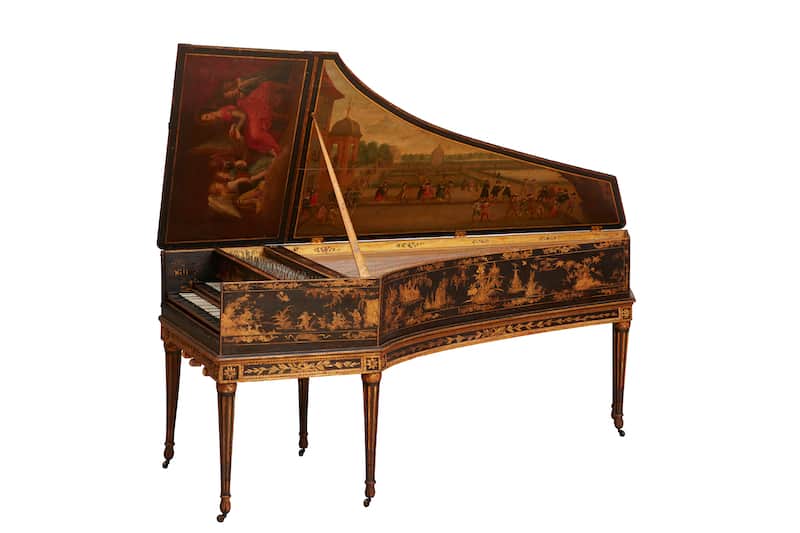
We’ve already referenced the Harpsichord as a parent of the modern piano. Physically, it looks very similar to an upright piano, only smaller.
The significant difference between a harpsichord and a piano is how the sound is made. While a piano’s keys are attached to hammers, a harpsichord’s keys are attached to hooks.
These hooks pluck the strings within the instrument instead of hitting them.
It makes a characteristic sound found on many Baroque instrumental pieces and requires technical precision. However, the musician can’t control dynamics, and the instrument has one volume: loud.
5. Clavichord
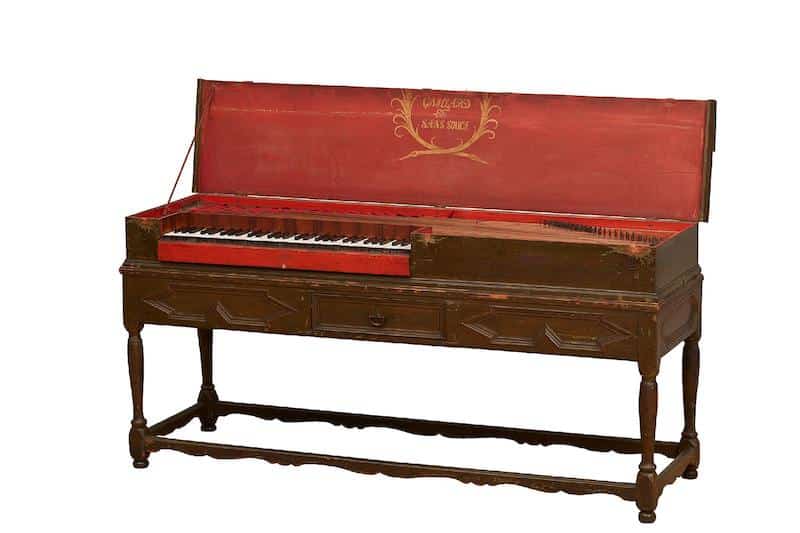
If a harpsichord is the mother of the piano, the Clavichord is the father. It looks much less similar but still operates with a keyboard.
The main difference between a clavichord and a harpsichord is the strings are struck by metal rods instead of plucked by hooks.
Similar to the harpsichord, the clavichord had one central issue: dynamics. While you could control how hard you hit the keys, the instrument is too small to make enough sound in a large concert hall.
Clavichords only had a few octaves and were primarily used in the home for practice or composition.
6. Pipe Organ
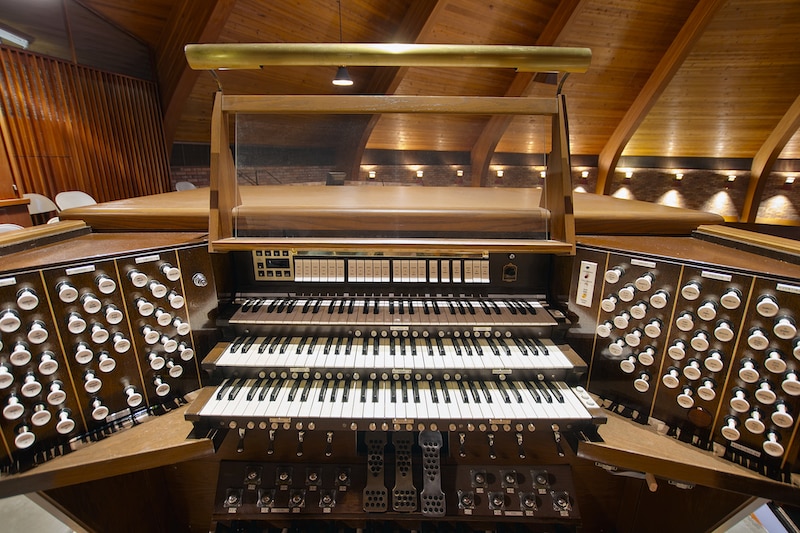
Before the clavichord or the harpsichord, however, was the Pipe Organ. The original keyboard instrument, variations of the organ have been around for over two thousand years.
The instrument pushes air through various pipes to make music using pedals, while the dual keyboards and a series of stops open and shut the pipes.
The pipe organ is used in large venues such as baseball stadiums, churches, and concert halls because it doesn’t need amplification to reach the back rows.
The largest pipe organ in the world is in Atlantic City, New Jersey, and consists of over 33,000 pipes.
7. Dulcitone
The Dulcitone is a somewhat unique take on the clavichord, developed in the 1800s. It borrows part of its name and design from the hammered dulcimer, which utilizes padded hammers hitting a string.
However, the dulcitone attaches these hammers to a keyboard in a portable version of the clavichord.
The dulcitone is a quiet and high-pitched instrument, generally only spanning four or five octaves.
While the dulcitone had its uses, it was often replaced by a louder, sharper-sounding percussion instrument such as a xylophone or a glockenspiel.
8. Synthesizer
Other than the piano, the Synthesizer might be the most popular keyboard instrument on this list. It’s different from an electric keyboard, however.
While both plug into a wall and look like a smaller version of a regular piano, synthesizers have varying functions and are capable of many different sounds.
A synthesizer makes tones electronic instead of manual. While a piano hits an actual hammer to a string, synth copies that noise with an internal computer.
If you hook a synth up to an external computer, there’s no end to the number of different sounds it can make.
The classic “synth” or electric keyboard sound, however, is well-known in classic rock.
9. Melodica
The Melodica is one of the newer instruments on this list. Although variations have been around for almost two hundred years, the modern (and most popular) version was invented in the 1950s.
It was made popular in reggae and ska music in the 1970s and 1980s. Think of the melodica as a recorder, but with a keyboard on top instead of openings.
It works the same way, with the musician blowing air through a top hole and controlling the sound by “stopping” specific openings.
The difference is that instead of directly seeing the holes, the musician is using the keyboard placed over the center tube.
10. Claviola
The Claviola is another twentieth-century hand-held keyboard that you blow into. Unlike the melodica, however, the claviola is no longer in production.
It was only made for a few years in the 1960s and is increasingly hard to find. It looks similar to an accordion and is held the same way but is easier to play.
The claviola works like a combination of the accordion and the melodica. The user blows through a pipe on the top of the instrument while playing the keyboard on the side.
On the opposite side of the keyboard, there are multiple pipes to correspond to the keys. The air brings the sound, and the keys control it.
11. Hurdy-Gurdy

If nothing else, this instrument has the most entertaining name on the list. The Hurdy-Gurdy.
Legends say that it came from the somewhat warbly sound that the instrument has when it starts.
There are a variety of hurdy-gurdies, but they all sound like a combination of an accordion and a violin. The hurdy-gurdy looks like a violin with a crank on the bottom and a keyboard along the side.
So although it’s technically a stringed instrument, it fits right in with the widespread family of keyboard instruments.
As the musician cranks the instrument and plays the keys, they slide over the strings to make the music.
12. Celeste
One of the more unique keyboards on this list, a Celeste, works similarly to a regular piano.
However, instead of the hammers hitting strings to create the signature piano sound, the hammers of a celeste hit sound plates directly above wooden resonators. The resulting sound is a bell tone.
The celesta looks like a smaller version of a regular piano and is often played by a pianist. However, the difference in sound makes the celesta sound almost magical.
The most famous use of theceleste in modern music is in the theme song for the Harry Potter movies.
13. Autoharp
The Autoharp is what happens when a hammered dulcimer and an accordion have a child.
Half of the instrument is strings pulled tightly across a wooden soundboard. The player plucks these strings with fingers or a pick.
A keyboard covers the other half and mutes all the strings except when the keys are depressed.
This combination of string and keyboard instruments leads to a very soft, controlled sound.
Unlike many of the other keyboard instruments, the autoharp sounds much more like a stringed instrument (unsurprisingly, it sounds a lot like a small harp).
It can be played flat on a table (like a keyboard) or upright (like a harp).
14. Virginals
Lastly, we have a Virginal. If we’re continuing with the family analogy, virginals (which often came in two and were called a pair of virginals) are the grandmother of the harpsichord.
The instrument works much the same way; it uses keys to pluck strings. However, it’s slightly smaller than the harpsichord.
The main difference between a harpsichord and a virginals is that the virginals are a pair of keyboards, each called a virginal.
The harpsichord consolidated the keyboards into one multi-octave set, but this predecessor instrument separated them by the size of the strings. It was commonly used in homes because of its small size.
Final Thoughts
Now that you know a few different kinds of keyboard instruments, you can go on a quest to discover more instruments with keyboards.
While there are vast technical differences between them, a basic knowledge of music and piano would be a good start for playing each of these.


